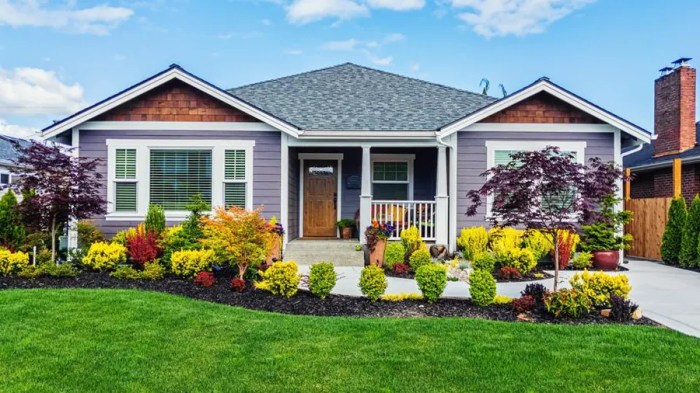Front yard garden design sets the stage for a welcoming home exterior. From boosting curb appeal to increasing property value, this guide dives into the essentials of creating a stunning outdoor space that leaves a lasting impression.
Importance of Front Yard Garden Design
Front yard garden design plays a crucial role in enhancing the overall curb appeal of a property. It is the first thing that guests or potential buyers see when approaching a home, making it a significant factor in creating a positive first impression.
Do not overlook the opportunity to discover more about the subject of Ideas for small outdoor spaces.
Enhancing Curb Appeal
A well-designed front yard garden can make a home stand out in the neighborhood, adding character and charm. By incorporating a variety of plants, flowers, and landscaping elements, it can create a welcoming and visually appealing entrance.
Increasing Property Value
In addition to improving the aesthetics of a home, a thoughtfully designed front yard garden can also increase the property’s value. Studies have shown that homes with well-maintained and attractive front yards tend to have higher resale values compared to those with neglected outdoor spaces.
Creating a Functional Space, Front yard garden design
When planning a front yard garden design, it is essential to consider both aesthetics and functionality. Incorporating elements such as pathways, seating areas, and lighting can make the space more usable and enjoyable for homeowners and visitors alike.
Elements of Front Yard Garden Design

When planning a front yard garden layout, there are several key elements to consider to create a beautiful and functional outdoor space. From plant selection to pathways and lighting, every aspect plays a crucial role in the overall design.
Plant Options Based on Sunlight Exposure
- For areas with full sunlight exposure, consider planting sun-loving plants such as roses, lavender, and succulents.
- In shaded areas, opt for plants that thrive in low light conditions like hostas, ferns, and begonias.
- For mixed sunlight conditions, choose versatile plants like hydrangeas, impatiens, and ornamental grasses.
Importance of Pathways, Lighting, and Seating Areas
Creating pathways in your front yard garden not only adds visual interest but also guides visitors through the space. Incorporating lighting fixtures can enhance the atmosphere and allow you to enjoy your garden during the evening hours. Additionally, adding seating areas like benches or chairs provides a relaxing spot to admire your garden and interact with nature.
Sustainable Practices in Front Yard Garden Design
Creating a sustainable front yard garden involves implementing eco-friendly landscaping options, water conservation techniques, and utilizing native plants and organic materials. These practices not only benefit the environment but also promote a healthier and more vibrant garden space.
Eco-Friendly Landscaping Options
- Planting drought-resistant plants that require less water and maintenance.
- Using permeable materials for pathways to reduce runoff and improve water absorption.
- Installing a rain garden to capture and filter rainwater, reducing water pollution.
- Incorporating a compost bin to recycle organic waste and enrich soil naturally.
Water Conservation Techniques
- Implementing drip irrigation systems to deliver water directly to plant roots, minimizing evaporation.
- Capturing rainwater in barrels for irrigation during dry periods.
- Mulching garden beds to retain soil moisture and reduce the need for frequent watering.
- Adjusting watering schedules based on weather conditions to avoid overwatering.
Benefits of Using Native Plants and Organic Materials
- Native plants are adapted to the local climate and require less water and maintenance.
- Organic materials, such as compost and mulch, improve soil health and fertility without harmful chemicals.
- Supporting biodiversity by attracting pollinators and beneficial insects to the garden.
- Reducing the use of synthetic fertilizers and pesticides that can harm the environment and human health.
Seasonal Maintenance for Front Yard Gardens
Keeping up with seasonal maintenance is crucial for the health and appearance of your front yard garden. Different tasks need to be done at different times of the year to ensure your garden thrives.
Spring
- Pruning: In spring, it’s essential to prune shrubs and trees to promote healthy growth and shape. Remove dead or damaged branches to encourage new growth.
- Weeding: Spring is the time when weeds start to grow vigorously. Regularly weed your garden to prevent them from taking over and competing with your plants for nutrients.
- Fertilizing: This is the time to fertilize your plants to support their growth during the active growing season. Use a balanced fertilizer to provide essential nutrients.
Summer
- Pruning: During summer, continue to prune any overgrown branches or dead flowers to maintain the shape and health of your plants.
- Weeding: Weeds can quickly take over in the summer heat. Regularly check and remove them to keep your garden looking neat and prevent them from suffocating your plants.
- Watering: With the hot weather, make sure to water your garden regularly, especially during dry spells, to keep your plants hydrated and healthy.
Fall
- Pruning: Fall is the time to prepare your garden for winter. Prune back any dead or diseased branches and flowers to prevent disease and promote new growth in the spring.
- Weeding: Before winter sets in, make sure to weed your garden one last time to prevent weeds from spreading seeds and coming back stronger in the spring.
- Mulching: Apply a layer of mulch to protect your plants’ roots from frost and provide insulation during the winter months.
Winter
- Protecting from Extreme Weather: During winter, protect your garden from frost and snow by covering delicate plants with burlap or bringing potted plants indoors.
- Planning: Use the winter months to plan and design any changes you want to make to your front yard garden for the upcoming spring.